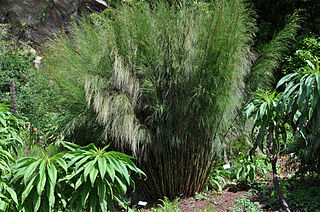
The Restionaceae, also called restiads and restios, are a family of flowering plants native to the Southern Hemisphere; they vary from a few centimeters to 3 meters in height. Following the APG IV (2016): the family now includes the former families Anarthriaceae, Centrolepidaceae and Lyginiaceae, and as such includes 51 genera with 572 known species. Based on evidence from fossil pollen, the Restionaceae likely originated more than 65 million years ago during the Late Cretaceous period, when the southern continents were still part of Gondwana.

Gentianaceae is a family of flowering plants of 103 genera and about 1600 species.

Phylica is a genus of plants in the family Rhamnaceae. It contains about 150 species, the majority of which are restricted to South Africa, where they form part of the fynbos. A few species occur in other parts of southern Africa, and on islands including Madagascar, the Mascarene Islands, Île Amsterdam, Saint Helena, Tristan da Cunha, and Gough Island. Phylica piloburmensis from the Burmese amber of Myanmar, dating to around 99 million years ago during the mid-Cretaceous, was originally described as the oldest fossil member of the genus, but subsequent studies contested its assignment to the genus Phylica and even to the family Rhamnaceae, with one study placing it in the separate genus Nothophylica.
Pentameris is a genus of plants in the grass family, native primarily to Africa, with a few species in Yemen and on certain islands in the Indian Ocean.
Anthochortus is a group of plants in the Restionaceae described as a genus in 1837. The entire genus is endemic to Cape Province in South Africa.

Askidiosperma is a group of plants in the Restionaceae described as a genus in 1850. The entire genus is endemic to Cape Province in South Africa.

Cannomois is a group of plants in the Restionaceae described as a genus in 1828. The entire genus is endemic to Cape Province in South Africa.

Ceratocaryum is a group of plants in the Restionaceae described as a genus in 1836. The entire genus is endemic to Cape Province in South Africa.
Nevillea is a group of plants in the Restionaceae described as a genus in 1984. The entire genus is endemic to Cape Province in South Africa.
Tenaxia is a genus of Asian and African plants in the grass family.
Capeochloa is a genus of South African plants in the grass family. It contains three species of perennial grasses endemic to the Cape Provinces.
Neville Stuart Pillans was a South African botanist.





